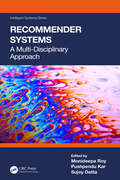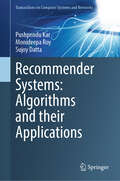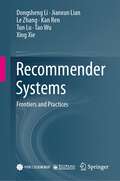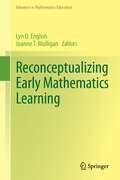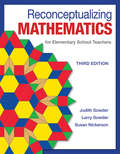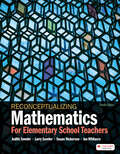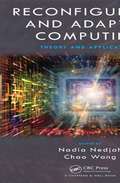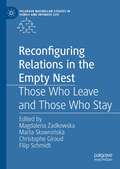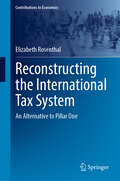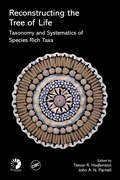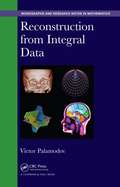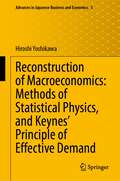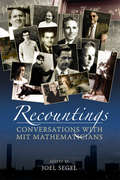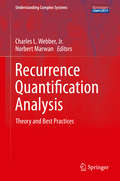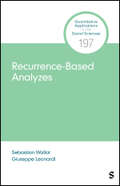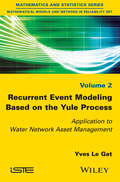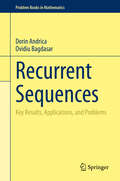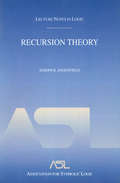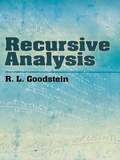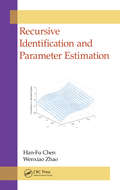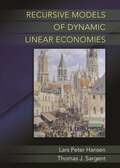- Table View
- List View
Recommender Systems: A Multi-Disciplinary Approach (Intelligent Systems)
by Monideepa Roy Pushpendu Kar Sujoy DattaRecommender Systems: A Multi-Disciplinary Approach presents a multi-disciplinary approach for the development of recommender systems. It explains different types of pertinent algorithms with their comparative analysis and their role for different applications. This book explains the big data behind recommender systems, the marketing benefits, how to make good decision support systems, the role of machine learning and artificial networks, and the statistical models with two case studies. It shows how to design attack resistant and trust-centric recommender systems for applications dealing with sensitive data. Features of this book: Identifies and describes recommender systems for practical uses Describes how to design, train, and evaluate a recommendation algorithm Explains migration from a recommendation model to a live system with users Describes utilization of the data collected from a recommender system to understand the user preferences Addresses the security aspects and ways to deal with possible attacks to build a robust system This book is aimed at researchers and graduate students in computer science, electronics and communication engineering, mathematical science, and data science.
Recommender Systems: Algorithms and their Applications (Transactions on Computer Systems and Networks)
by Monideepa Roy Pushpendu Kar Sujoy DattaThe book includes a thorough examination of the many types of algorithms for recommender systems, as well as a comparative analysis of them. It addresses the problem of dealing with the large amounts of data generated by the recommender system. The book also includes two case studies on recommender system applications in healthcare monitoring and military surveillance. It demonstrates how to create attack-resistant and trust-centric recommender systems for sensitive data applications. This book provides a solid foundation for designing recommender systems for use in healthcare and defense.
Recommender Systems: Frontiers and Practices
by Xing Xie Tun Lu Tao Wu Dongsheng Li Le Zhang Jianxun Lian Kan RenThis book starts from the classic recommendation algorithms, introduces readers to the basic principles and main concepts of the traditional algorithms, and analyzes their advantages and limitations. Then, it addresses the fundamentals of deep learning, focusing on the deep-learning-based technology used, and analyzes problems arising in the theory and practice of recommender systems, helping readers gain a deeper understanding of the cutting-edge technology used in these systems. Lastly, it shares practical experience with Microsoft 's open source project Microsoft Recommenders. Readers can learn the design principles of recommendation algorithms using the source code provided in this book, allowing them to quickly build accurate and efficient recommender systems from scratch.
Reconceptualizing Early Mathematics Learning
by Joanne T. Mulligan Lyn D. EnglishThis book emanated primarily from concerns that the mathematical capabilities of young children continue to receive inadequate attention in both the research and instructional arenas. Research over many years has revealed that young children have sophisticated mathematical minds and a natural eagerness to engage in a range of mathematical activities. As the chapters in this book attest, current research is showing that young children are developing complex mathematical knowledge and abstract reasoning a good deal earlier than previously thought. A range of studies in prior to school and early school settings indicate that young learners do possess cognitive capacities which, with appropriately designed and implemented learning experiences, can enable forms of reasoning not typically seen in the early years. Although there is a large and coherent body of research on individual content domains such as counting and arithmetic, there have been remarkably few studies that have attempted to describe characteristics of structural development in young students' mathematics. Collectively, the chapters highlight the importance of providing more exciting, relevant, and challenging 21st century mathematics learning for our young students. The chapters provide a broad scope in their topics and approaches to advancing young children's mathematical learning. They incorporate studies that highlight the importance of pattern and structure across the curriculum, studies that target particular content such as statistics, early algebra, and beginning number, and studies that consider how technology and other tools can facilitate early mathematical development. Reconceptualising the professional learning of teachers in promoting young children's mathematics, including a consideration of the role of play, is also addressed.
Reconceptualizing Mathematics for Elementary School Teachers, Third Edition
by Judith Sowder Larry Sowder Susan NickersonReconceptualizing Mathematics, founded on research and studies of learning and mathematics teaching for many years, is designed for use in classrooms in which students take an active part in learning and experience doing math. The esteemed author team has written the only textbook of its kind to both incorporate aspects of student-centered learning into lessons and model the teaching that will be expected of their students. To this end, the authors provide worthwhile tasks, activities, and support for facilitating discussions. Quantitative reasoning and problem solving are recurring themes in Reconceptualizing Mathematics. The authors approach problem solving that teaches students to understand the quantities embedded in the situation and how they relate to each other.
Reconceptualizing Mathematics: for Elementary School Teachers
by Judith Sowder Larry Sowder Susan Nickerson Ian WhitacreLearn by doing with active resources, discussions, and support in Reconceptualizing Mathematics and Achieve! Student-centered lessons model the teaching that will eventually be expected of you as you gain valuable hands-on experience with technology, problem solving, and quantitative reasoning.
Reconfigurable and Adaptive Computing: Theory and Applications
by Nadia Nedjah Chao WangReconfigurable computing techniques and adaptive systems are some of the most promising architectures for microprocessors. Reconfigurable and Adaptive Computing: Theory and Applications explores the latest research activities on hardware architecture for reconfigurable and adaptive computing systems.The first section of the book covers reconfigurable systems. The book presents a software and hardware codesign flow for coarse-grained systems-on-chip, a video watermarking algorithm for the H.264 standard, a solution for regular expressions matching systems, and a novel field programmable gate array (FPGA)-based acceleration solution with MapReduce framework on multiple hardware accelerators.The second section discusses network-on-chip, including an implementation of a multiprocessor system-on-chip platform with shared memory access, end-to-end quality-of-service metrics modeling based on a multi-application environment in network-on-chip, and a 3D ant colony routing (3D-ACR) for network-on-chip with three different 3D topologies.The final section addresses the methodology of system codesign. The book introduces a new software–hardware codesign flow for embedded systems that models both processors and intellectual property cores as services. It also proposes an efficient algorithm for dependent task software–hardware codesign with the greedy partitioning and insert scheduling method (GPISM) by task graph.
Reconfiguring Relations in the Empty Nest: Those Who Leave and Those Who Stay (Palgrave Macmillan Studies in Family and Intimate Life)
by Christophe Giraud Magdalena Żadkowska Marta Skowrońska Filip SchmidtThis edited volume traverses the spectrum of experiences that take place after children leave the family home and parents find themselves in the "empty nest" stage of life. Rather than focusing on measuring the intensity of empty nest syndrome or asking whether parents' marital satisfaction increases or decreases in this phase, the authors present rich qualitative data from across Poland and France to show that there is great variation in how families experience the empty nest, developing both a study on intimacy and love and on family solidarity. Throughout the book, themes of mixed emotions, nuanced attitudes, contradictions, and dissonance are explored while shedding light on "supporting actors" of the empty nest transition, such as family pets and material objects.
Reconstructing the International Tax System: An Alternative to Pillar One (Contributions to Economics)
by Elizabeth RosenthalSource-based taxation and the arm’s length standard have been foundational elements of the international tax system for many decades. With the advent of the highly digitalized platform firm, the OECD and many other stakeholders assert that these principles have been rendered obsolete. In their stead, these stakeholders have proposed an alternative hybrid international tax system. Under this proposed hybrid system, the long-standing profit allocation rules would be applied in the first instance to determine the preliminary attribution of in-scope multinational firms’ taxable income to individual taxing jurisdictions. These results would then be subject to a secondary reallocation designed to ensure that a portion of such firms’ taxable income is attributed to, and taxable by, jurisdictions in which consumers and users reside (“market jurisdictions”). This secondary allocation – the core of the OECD’s Pillar One and an essential element of its two-pronged “Pillar One-Pillar Two Solution” – explicitly deviates from both the arm’s length standard and the principle of source-based taxation. For many reasons, examined in this book, the OECD’s Pillar One would not provide for the effective taxation of highly digitalized platform firms, and, by extension, it would not stabilize the international tax system. The author argues that source-based taxation and the arm’s length standard are entirely compatible with the attribution of a portion of highly digitalized platform firms’ taxable income to market jurisdictions. However, new transfer pricing methodologies and a revised definition of ‘control’ for transfer pricing purposes are required to achieve this result. Combining important findings and insights from academic research in a variety of fields with the author’s extensive practical experience in both public and private spheres, this book is appropriate for academics as well as private sector advisors in the fields of transfer pricing and international tax, chief financial officers of multinational corporations and tax policy analysts.
Reconstructing the Tree of Life: Taxonomy and Systematics of Species Rich Taxa
by Trevor R. Hodkinson John A. N. ParnellTo document the world's diversity of species and reconstruct the tree of life we need to undertake some simple but mountainous tasks. Most importantly, we need to tackle species rich groups. We need to collect, name, and classify them, and then position them on the tree of life. We need to do this systematically across all groups of organisms and b
Reconstruction from Integral Data (Chapman & Hall/CRC Monographs and Research Notes in Mathematics)
by Victor PalamodovReconstruction of a function from data of integrals is used for problems arising in diagnostics, including x-ray, positron radiography, ultrasound, scattering, sonar, seismic, impedance, wave tomography, crystallography, photo-thermo-acoustics, photoelastics, and strain tomography. Reconstruction from Integral Data presents both long-standing and r
Reconstruction of Macroeconomics: Methods Of Statistical Physics, And Keynes Principle Of Effective Demand (Advances in Japanese Business and Economics #3)
by Hiroshi YoshikawaThis book explains how standard micro-founded macroeconomics is misguided and proposes an alternative method based on statistical physics. The Great Recession following the bankruptcy of Lehman Brothers in September 2015 amply demonstrated that mainstream micro-founded macroeconomics was in trouble. The new approach advanced in this book reasonably explains important macro-problems such as employment, business cycles, growth, and inflation/deflation. The key concept is demand failures, which modern micro-founded macroeconomics has ignored. “It (Chapter 3) captures analytically a good part of the intuition that underlies the Keynesian economics of people like Tobin and me.” Robert Solow, Emeritus Institute Professor of Economics, Massachusetts Institute of Technology, Nobel Laureate in Economics, 1987“Professor Hiroshi Yoshikawa provides a unique synthesis of statistical physics and macro-economic theory in order to confront the dismal failure in economics and in finance to understand how an economy or a financial market works, given the heterogeneous decision making of many different individual interacting actors. Economics has failed in this regard with the naive and often misleading concept of “representative agents.” The author presents many insights on the historical development, concepts, and errors made by the most illustrious economists in the past. This book should be essential readings for any economics students as well as academic researchers and policy makers, who should learn to bring back good-sense thinking in their impactful decisions.”Didier Sornette, Professor on the Chair of Entrepreneurial Risks at the Swiss Federal Institute of Technology Zurich (ETH Zurich)
Reconstruction of Macroscopic Maxwell Equations
by Kikuo ChoThis book presents a logically more complete form of macroscopic Maxwell equations than the conventional ones by applying long wavelength approximation to microscopic nonlocal theory. This scheme requires only one susceptibility tensor describing electric and magnetic polarizations together with their mutual interference. The quantum mechanical expression of the susceptibility covers both chiral and achiral symmetry. Only in the absence of chiral symmetry, this reduces to the conventional form, under the additional condition of using magnetic susceptibility defined with respect to, not H, but B. This scheme solves various problems inherent to the conventional scheme of Maxwell equations.
Recountings: Conversations with MIT Mathematicians
by Joel SegelThis book traces the history of the MIT Department of Mathematics-one of the most important mathematics departments in the world-through candid, in-depth, lively conversations with a select and diverse group of its senior members. The process reveals much about the motivation, path, and impact of research mathematicians in a society that owes so mu
Recoverable Mutual Exclusion: Using Persistent Memory (Synthesis Lectures on Distributed Computing Theory)
by Neeraj Mittal Sahil Dhoked Wojciech GolabThis book discusses the recent research work on designing efficient fault-tolerant synchronization mechanisms for concurrent processes using the relatively new persistent memory technology that combines the low latency benefits of DRAM with the persistence of magnetic disks. The authors include all of the major contributions published to date, and also convey some perspective regarding how the problem itself is evolving. The results are described at a high level to enable readers to gain a quick and thorough understanding of the RME problem and its nuances, as well as various solutions that have been designed to solve the problem under a variety of important conditions and how they compare to each other.
Recurrence Quantification Analysis
by Jr. Norbert Marwan Charles L. WebberThe analysis of recurrences in dynamical systems by using recurrence plots and their quantification is still an emerging field. Over the past decades recurrence plots have proven to be valuable data visualization and analysis tools in the theoretical study of complex, time-varying dynamical systems as well as in various applications in biology, neuroscience, kinesiology, psychology, physiology, engineering, physics, geosciences, linguistics, finance, economics, and other disciplines. This multi-authored book intends to comprehensively introduce and showcase recent advances as well as established best practices concerning both theoretical and practical aspects of recurrence plot based analysis. Edited and authored by leading researcher in the field, the various chapters address an interdisciplinary readership, ranging from theoretical physicists to application-oriented scientists in all data-providing disciplines.
Recurrence-Based Analyses (Quantitative Applications in the Social Sciences)
by Sebastian Wallot Giuseppe LeonardiThis book introduces techniques developed in physics and physiology for characterizing and analyzing patterns in time series data to a broad audience of social scientists. In contrast to time-series regression and related techniques, recurrence quantification analysis (RQA) has its background in chaos and nonlinear dynamical systems—theory arguably very relevant to social processes. The goal of Recurrence-Based Analyses is to introduce readers to these techniques that can characterize a system’s complexity, stability and instability, and conditions under which it transitions from one state to another. The authors illustrate concepts and techniques with relevant social science examples at different temporal scales: biweekly polling data on federal elections in Germany; daily values of three stock market indices; daily cases of SarsCov-19 in four countries during the pandemic; and second-by-second vocalizations of mothers and infants interacting recorded by motion cameras. This introduction to RQA serves as a useful supplement to undergraduate and graduate courses in computational social science, and also by researchers who seek new tools to address social scientific questions in new ways.
Recurrence-Based Analyses (Quantitative Applications in the Social Sciences)
by Sebastian Wallot Giuseppe LeonardiThis book introduces techniques developed in physics and physiology for characterizing and analyzing patterns in time series data to a broad audience of social scientists. In contrast to time-series regression and related techniques, recurrence quantification analysis (RQA) has its background in chaos and nonlinear dynamical systems—theory arguably very relevant to social processes. The goal of Recurrence-Based Analyses is to introduce readers to these techniques that can characterize a system’s complexity, stability and instability, and conditions under which it transitions from one state to another. The authors illustrate concepts and techniques with relevant social science examples at different temporal scales: biweekly polling data on federal elections in Germany; daily values of three stock market indices; daily cases of SarsCov-19 in four countries during the pandemic; and second-by-second vocalizations of mothers and infants interacting recorded by motion cameras. This introduction to RQA serves as a useful supplement to undergraduate and graduate courses in computational social science, and also by researchers who seek new tools to address social scientific questions in new ways.
Recurrent Event Modeling Based on the Yule Process
by Yves Le GatThis book presents research work into the reliability of drinking water pipes. The infrastructure of water pipes is susceptible to routine failures, namely leakage or breakage, which occur in an aggregative manner in pipeline networks. Creating strategies for infrastructure asset management requires accurate modeling tools and first-hand experience of what repeated failures can mean in terms of socio-economic and environmental consequences. Devoted to the counting process framework when dealing with this issue, the author presents preliminary basic concepts, particularly the process intensity, as well as basic tools (classical distributions and processes). The introductory material precedes the discussion of several constructs, namely the non-homogeneous birth process, and further as a special case, the linearly extended Yule process (LEYP), and its adaptation to account for selective survival. The practical usefulness of the theoretical results is illustrated with actual water pipe failure data.
Recurrent Sequences: Key Results, Applications, and Problems (Problem Books in Mathematics)
by Ovidiu Bagdasar Dorin AndricaThis self-contained text presents state-of-the-art results on recurrent sequences and their applications in algebra, number theory, geometry of the complex plane and discrete mathematics. It is designed to appeal to a wide readership, ranging from scholars and academics, to undergraduate students, or advanced high school and college students training for competitions. The content of the book is very recent, and focuses on areas where significant research is currently taking place. Among the new approaches promoted in this book, the authors highlight the visualization of some recurrences in the complex plane, the concurrent use of algebraic, arithmetic, and trigonometric perspectives on classical number sequences, and links to many applications. It contains techniques which are fundamental in other areas of math and encourages further research on the topic. The introductory chapters only require good understanding of college algebra, complex numbers, analysis and basic combinatorics. For Chapters 3, 4 and 6 the prerequisites include number theory, linear algebra and complex analysis. The first part of the book presents key theoretical elements required for a good understanding of the topic. The exposition moves on to to fundamental results and key examples of recurrences and their properties. The geometry of linear recurrences in the complex plane is presented in detail through numerous diagrams, which lead to often unexpected connections to combinatorics, number theory, integer sequences, and random number generation. The second part of the book presents a collection of 123 problems with full solutions, illustrating the wide range of topics where recurrent sequences can be found. This material is ideal for consolidating the theoretical knowledge and for preparing students for Olympiads.
Recursion Theory: Lecture Notes in Logic 1 (Lecture Notes in Logic #1)
by Joseph R. ShoenfieldThis volume, which ten years ago appeared as the first in the acclaimed series Lecture Notes in Logic, serves as an introduction to recursion theory. The fundamental concept of recursion makes the idea of computability accessible to a mathematical analysis, thus forming one of the pillars on which modern computer science rests. The clarity and focus of this text have established it as a classic instrument for teaching and self-study that prepares its readers for the study of advanced monographs and the current literature on recursion theory.
Recursive Analysis (Dover Books on Mathematics)
by R. L. GoodsteinRecursive analysis develops natural number computations into a framework appropriate for real numbers. This text is based upon primary recursive arithmetic and presents a unique combination of classical analysis and intuitional analysis. Written by a master in the field, it is suitable for graduate students of mathematics and computer science and can be read without a detailed knowledge of recursive arithmetic.Introductory chapters on recursive convergence and recursive and relative continuity are succeeded by explorations of recursive and relative differentiability, the relative integral, and the elementary functions. A final chapter examines transfinite ordinals, and the text concludes with a helpful appendix of topics related to recursive irrationality and transcendence.
Recursive Identification and Parameter Estimation
by Han-Fu Chen Wenxiao ZhaoRecursive Identification and Parameter Estimation describes a recursive approach to solving system identification and parameter estimation problems arising from diverse areas. Supplying rigorous theoretical analysis, it presents the material and proposed algorithms in a manner that makes it easy to understand-providing readers with the modeling and
Recursive Models of Dynamic Linear Economies (The Gorman Lectures in Economics #6)
by Thomas J. Sargent Lars Peter HansenA guide to the economic modeling of household preferences, from two leaders in the fieldA common set of mathematical tools underlies dynamic optimization, dynamic estimation, and filtering. In Recursive Models of Dynamic Linear Economies, Lars Peter Hansen and Thomas Sargent use these tools to create a class of econometrically tractable models of prices and quantities. They present examples from microeconomics, macroeconomics, and asset pricing. The models are cast in terms of a representative consumer. While Hansen and Sargent demonstrate the analytical benefits acquired when an analysis with a representative consumer is possible, they also characterize the restrictiveness of assumptions under which a representative household justifies a purely aggregative analysis.Hansen and Sargent unite economic theory with a workable econometrics while going beyond and beneath demand and supply curves for dynamic economies. They construct and apply competitive equilibria for a class of linear-quadratic-Gaussian dynamic economies with complete markets. Their book, based on the 2012 Gorman lectures, stresses heterogeneity, aggregation, and how a common structure unites what superficially appear to be diverse applications. An appendix describes MATLAB programs that apply to the book's calculations.
Red Sox vs. Yankees: Hometown Experts Analyze, Debate, and Illuminate Baseball's Ultimate Rivalry (Classic Sports Rivalries #1)
by David Fischer Bill NowlinTeddy Ballgame or the Great Bambino? Nomar or Jeter? Clemens or Clemens? For more than 115 years, the Boston Red Sox and New York Yankees have been battling it out on the diamond, playing each other over 2,000 times. This heated rivalry has stood the test of time, as one team’s triumph usually means the other’s dismay. While the teams battle on the field, the fans and cities take the rivalry just as seriously. But who’s the best? Which team’s players have the edge? Which team’s squad would reign supreme? If you ask a New Yorker, you’ll get an obvious answer; same with a Bostonian. But what happens when two men from opposite sides of the track sit down to discuss who is the best?Red Sox vs. Yankees pairs baseball historians Bill Nowlin (Red Sox) and David Fischer (Yankees) to discuss who each team’s best position player was and which super team would win in a head-to-head series. Obviously, they won’t easily agree. Obviously, there will be cheap shots and venom spewed back and forth. But in the end, we will have two teams: one of the greatest players and one of each squad’s best year. You can guess that Nowlin will say that the Sox will win, while Fischer is confident that the Yanks will be victorious. But it’s not that easy. Thanks to the help of Action! PC Baseball, we will have a simulation to find out which team would win in a head-to-head battle. Will the All-Star Yankees take the series? Will the Red Sox pummel the best the Bronx has to offer? There’s only one way to find out.
